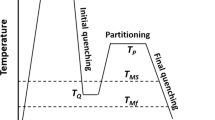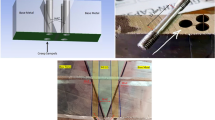The effect of boronizing on the mechanical properties, wear, and corrosion of boronized N80 tube steel is studied. A dual-phase boride layer consisting of the FeB and F2B phases is formed on the surface of steel substrate within the hardness range 1220–1340 HV. A special setup was designed to use smaller amounts of the boriding agent and accelerate the process of cooling of the pipe. In order to meet the tensile properties of N80 steel required by the API SPEC 5 L, four cooling methods were employed. The procedure of fan cooling with a graphite bar inside the boriding agent resulted in the highest mechanical properties in accordance with the mechanical properties of the API SPEC 5 L. The boronized N80 steel reveal a high wear resistance under the conditions of dry sliding and excellent corrosion resistance in the as-received oil-field water from the Jilin oil field, Northeast China.




Similar content being viewed by others
References
A. K. Sinha, “Boronizing,” in: ASM Handbook, OH, J. Heat Treat., USA (1991), pp. 437–440.
P. Goeuriout, F. Thevenot, J. Thevenot, and H. Driver, “Surface treatment of steels: Borudif, a new boriding process,” Thin Solid Film., 78, 67–76 (1981).
U. Sen, S. Sen, and Yilmaz F., “An evaluation of some properties of borides deposited on boronized ductile iron,” J. Mater. Process. Tech., 148, 1–7 (2004).
B. Selcuk, R. Ipek, and M. B. Karamis, “An investigation of surface properties of treated low-carbon and alloyed steels (boriding and carburizing,” J. Mater. Process. Tech., 141, 189–196 (2003).
P. Asthana, H. Liang, M. Usta, and A. H. Ucisik, “Wear and surface characterization of boronized pure iron,” J. Tribol., 129, 1–10 (2007).
O. I. Radkevych, H. V. Chumalo, I. M. Dominyuk, and I. I. Vasylenko, “Degradation of the tubing metal in hydrogen-sulfide environments,” Mater. Sci., 38, No. 6, 884–888 (2002).
V. V. Zavyalov and L. S. Moiseeva, “Chemical, hydrodynamic, and metallurgical factors in west-Siberian oil pipeline corrosion failures,” Chem. Petroleum Eng., 40, 45–50 (2004).
H. J. Hungar and G. Trute, “Boriding to produce wear resistance surface layer,” Heat Treatment Met., 2, 31–39 (1994).
Acknowledgements
The authors thank the Project 985-automotive engineering of the Jilin University.
Author information
Authors and Affiliations
Corresponding author
Additional information
Published in Fizyko-Khimichna Mekhanika Materialiv, Vol. 48, No. 1, pp. 100–105, January–February, 2012.
Rights and permissions
About this article
Cite this article
Xu, D.S., Xu, X., Su, Z.G. et al. Mechanical properties, wear, and corrosion of boronized N80 tube steel. Mater Sci 48, 106–112 (2012). https://doi.org/10.1007/s11003-012-9479-9
Received:
Published:
Issue Date:
DOI: https://doi.org/10.1007/s11003-012-9479-9




